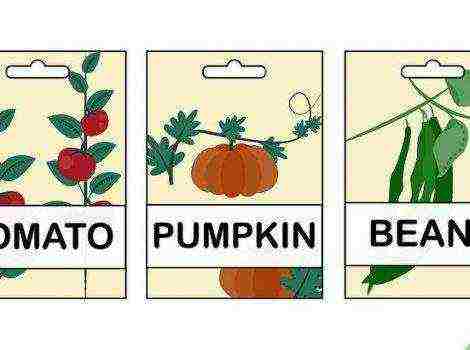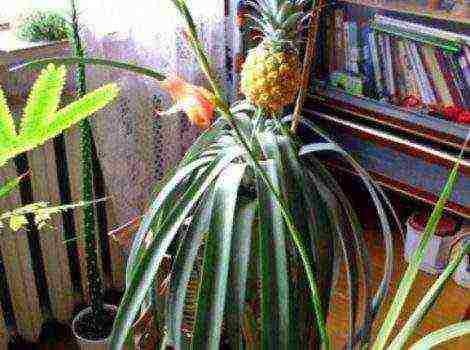Content [show]
Growing tobacco or makhorka is not difficult at all. We are often asked about this process, and, combining personal experience with the advice of experienced ones, including our readers, we decided to publish this material. I must say that the process of growing tobacco is not much different from growing, for example, tomatoes. But still, growing tobacco, you need to know certain features of this plant. This is what our publication is about.
Content:
- General information about the tobacco plant
- Should you grow tobacco?
- Features of growing tobacco
- Tobacco pests and diseases
- Tobacco drying and fermentation
General information about the tobacco plant
Tobacco (Nicotiana) is a genus of perennial and annual plants of the Solanaceae family. Grown to obtain raw materials used in tobacco products. In culture, the following types are most often found:
- Ordinary tobacco, or Virginia Tobacco, or Real Tobacco (Nicotiana tabacum). The plant is up to 3 m high with pink flowers, a tubular corolla with sharp lobes, leaves are oblong-lanceolate, sessile. Real tobacco is quite thermophilic, therefore it is especially productively grown in hot regions. In our country, ordinary tobacco is grown south of 55 ° north latitude (this is approximately the latitude of Ryazan, Smolensk, Ulyanovsk, Ufa, Chelyabinsk, Kurgan, Omsk, Novosibirsk and Kemerovo). Ordinary tobacco is cultivated in many countries of the world and has many varieties.
- Common shag, or Rustic tobacco (Nicotiana rustica) - a plant much lower than ordinary tobacco (up to 120 cm high), yellowish flowers, corolla with a short tube and rounded blades, ovoid leaves, narrow, obtuse at the end. The leaves of this more unpretentious plant contain half as much nicotine.
In the 19th century in Russia, makhorka was cultivated on an industrial scale everywhere (even in the Urals and Siberia). Even now, some villagers traditionally grow this plant from their own seeds.
Bolivia and Peru are considered the homeland of tobacco; it was brought to Europe by the expeditions of Christopher Columbus. Traditional areas of cultural cultivation - North America, China, India, Asia Minor. On the territory of the former USSR, ordinary tobacco is cultivated in the Transcaucasus, Uzbekistan, Kazakhstan, Moldova, Ukraine, Crimea and Krasnodar Territory. Tobacco is a thermophilic plant, the optimal summer temperature for it is about 30 ° C. Moist, light, free-flowing sandy soils are suitable for it. Tobacco is propagated by seeds, growing seedlings from them, which are then planted in the ground.
All parts of the plant contain nicotine (nicotine leaves most of all - 0.75-2.88%). Nicotine is a potent neurotoxin and cardiotoxin that causes short-term euphoria. The use of tobacco in various forms and in various ways (smoking, chewing, sniffing) causes physical and psychological dependence. Nicotine is extremely toxic. Some of the substances in tobacco are carcinogenic. therefore smoking tobacco is dangerous to health.
Should you grow tobacco?
Suppose you are a smoker, and you have the good fortune to live somewhere in the south of Russia or in Ukraine. You have at your disposal several acres of land. Why not try on the role of Philip Morris or at least Jack Vosmerkin, an American?
First, some fun arithmetic. One cigarette contains about a gram of tobacco. And the cheaper the cigarettes, the less it is there. That is, the pack contains about 20 grams. If a person smokes a pack a day, he will need about 6-8 kilograms of tobacco per year.
Under favorable conditions, about 30 g of smoking tobacco can be obtained from one plant, and six to seven plants can be placed on 1 square meter. The planting density of large-leaved varieties is 70 × 30 cm, and the planting density of medium-sized tobacco and makhorka is 70 × 20 cm.It turns out that you need to grow 270-300 plants, occupying about 40 square meters. m. plot. Moreover, if the tobacco turned out to be too "evil", it can be diluted with the stems.
Therefore, from the point of view of economy and finances, it is definitely profitable for a smoker to grow tobacco.
Features of growing tobacco
Further in the article we will talk about the cultivation of ordinary tobacco. If you decide to grow shag (Nicotiana rustica), then you will not need many of the tips given, shag is much easier to grow and less thermophilic. For the middle lane, it is sown in May in the ground under a film or covering material, and it has time to grow and give a crop.
So, the first thing to attend to is the seeds and their planting. Seeds are now sold on the Internet on many sites, you just need to choose a store convenient for you and a variety of tobacco.
Tobacco varieties
There are many varieties of ordinary tobacco. It is worth saying that for the period from 1990 to 2010. in the All-Russian Research Institute of Tobacco, more than 20 new productive and disease-resistant varieties of tobacco with excellent characteristics have been bred.
As with vegetables, it is better to choose local varieties for your site. Therefore, we list some popular varieties that are zoned for the territories of the former USSR:
- Refectory Kubanets. The growing season from planting seedlings to the last breaking is 103-134 days. Technically suitable leaves on average 27 pcs. Nicotine content 2.6%.
- Refectory 92. The variety is resistant to numerous damaging factors, viral tobacco diseases. It has a short growing season. On average, leaf breaking occurs 98 days after planting.
- Samsun 85. The variety belongs to intensively ripening varieties, mid-season - the number of days from planting to leaf breaking will be approximately 105-110 days. The number of technically ripe leaves from one tobacco bush is about 50 pcs.
- Jubilee new 142. The growing season from planting seedlings to ripening of leaves of average breaking is 78 days, to the last breaking 82 days. The nicotine content in the leaves is 2.0-2.1%. The variety has a complex resistance to tobacco diseases.
- Holly 316. Late-ripening form, intensive type of leaf maturation. Low in nicotine. From planting to maturation of the leaves of the last breaking 120 days.
Planting seeds
We recommend growing just a few bushes for the first year. So you will test your strength and find out all the nuances of the process. Therefore, you need very few seeds to get started. Tobacco seeds are as small as dust. There are about 12 thousand tobacco seeds in one gram, and about 4 thousand pieces of makhorka. To get the annual "norm" of a smoker, you need to sow only a quarter of a gram of tobacco seeds or three-quarters of a gram of tobacco seeds. You don't have to buy seeds anymore. Two or three bushes will give them more than needed for sowing a hectare.
Tobacco seeds remain viable for a long time, so sowing with old seeds is also possible, although it must be borne in mind that their germination decreases over time.
Tobacco can be planted on the seedlings on the windowsills, with or without a pick. The required age of seedlings is 40-45 days. But this technique is good only for small (up to a quarter of a hundred) volumes. However, for the first experiment, we don't need more. When growing tobacco in large volumes, it is either immediately planted in the ground (in warm climates), or greenhouses and nurseries are used.
Tobacco seeds are sown superficially, scattering them over wet soil.
An important point. The seeding depth of tobacco seeds is no more than 0.7-0.8 cm (0.3-0.5 cm for shag). After sowing, they are only slightly pressed into the ground and watered very carefully so that the seeds do not go deep.
You can sow not dry seeds, but hatched seeds.In this case, 4 days before sowing, the seeds are soaked in warm clean water and placed on a damp cloth. This will speed up the germination of the seeds and shorten the time to forcing the seedlings by a week.
The optimum temperature for germination of tobacco seeds is + 25ºC… + 28ºC. If the temperature is lower, then this can delay the emergence of plants, or even destroy them altogether.
It is impossible to overmoisten, as well as overdry the seedlings. It is best to water a little, almost daily.
Transplanting
Seedlings are planted when it reaches a height of 15 cm, has 5-6 developed true leaves and a well-developed root system. At this point, the danger of spring frosts should be avoided outside the window, and the soil at a depth of 10 cm should warm up above 10 ° C. This period is different in different regions, but approximately it is from the end of April to the end of May.
A week before planting, it is necessary to start hardening the seedlings, reducing watering and accustoming them to open air. 2-3 days before planting, watering the seedlings is completely stopped, watering abundantly only 2-3 hours before planting.
Plants are planted one at a time in the holes, after pouring 1 liter of water into them. In general, the process is very similar to planting tomato seedlings. And of course, every transplant is a shock for the plant. Therefore, it is advisable to preserve on the roots the soil in which the seedlings grew.
Care
During the growing period, it is necessary to regularly loosen the ground, remove weeds, feed and water. You can feed the plants based on the fertilization rates of tomatoes. Watering is usually limited to two to three waterings per summer, consuming 6-8 liters of water per plant. It is better to water the tobacco insufficiently than to water it.
A rooted tobacco bush can have roots up to several meters, and many tobacco growers find watering mature bushes harmful. However, it would be nice to water the tobacco a few days before harvesting.
In flowering plants, inflorescences are broken off (vershoking) and lateral shoots are regularly removed (pinching).
The soil
Tobacco is planted on fresh soil, in the absence of such, it is placed either after steam, or after winter crops or other plants that impose other nutrient requirements on the soil. For this reason, tobacco should not be planted, for example, after beets and potatoes.
The best soils for tobacco should be considered sandy loam, characterized by the presence of potassium and nitrogen, which are necessary for the tobacco plant.
Like all immigrants from the New World, tobacco is rapidly depleting the soil. But the remedy is known - fertilizers perfectly solve this problem.
The best fertilizer for tobacco is cow dung. Bird droppings and oilcakes are also considered useful fertilizers for tobacco. On soils poor in lime, liming is used, it has a beneficial effect not only on the culture, but also on the completeness of combustion of the tobacco plant.
Harvesting begins when the color of the tobacco leaves changes from green to yellow-green or light green. Since even one bush will have leaves of varying degrees of color, harvesting can take several weeks.
Tobacco pests and diseases
Tobacco is damaged by a number of pests, namely:
- Peach aphid, Greenhouse aphids, Tobacco aphids. Dangerous tobacco pest. A widespread species, it feeds on many cultivated and wild plants. Peach aphid inhabits all organs of the tobacco plant and sucks the juice out of them, which leads to a decrease in the yield and quality of raw materials.
- Blackleg... It is manifested by lodging and mass death of seedlings. The base of the stems becomes thinner and decays. A brown or white bloom appears on the affected surface. The pathogen remains in the soil.
- Powdery mildew. It is observed soon after planting seedlings in the ground. Separate spots with a cobweb-powdery bloom appear on the lower leaves; then the plaque becomes solid and covers the upper leaves. The mushroom hibernates on plant debris. The disease reduces photosynthesis, leads to plant oppression. Reduces the yield and quality of raw materials.
- Black root rot more often it affects seedlings, but adult plants also get sick.On the affected seedlings, the leaves wilt, turn yellow and dry out, the roots turn brown or black and often die off. In adult plants, the leaves become attached, and black and white spots form at the ends of the roots.
- Common broomstick... Distributed throughout the south and southeast of Kazakhstan. The parasite settles on the roots of tobacco and develops at the expense of the host plant, forming a powerful branching stem of purple color. As a result of mass destruction of plants by broomrape, the yield of tobacco and the quality of raw materials are reduced. Broomrape propagates by seeds that remain in the soil for many years.
- Mosaic... The leaves of diseased plants have normal green patches that alternate with light green. Later, the tissue dies off in spots. The main source of plant infection is post-harvest residues of diseased plants, both in greenhouses and in the field.
- Bacterial hazel grouse. Oily or weeping spots appear on the tips of the leaves of young seedlings or along the edges of the leaves. In wet weather, they rot, and the whole plant becomes infected from them. Round chlorotic spots appear on the leaves of grown plants, which merge, forming patches of dead tissue. The causative agent of the disease is stored in tobacco leaves, in tobacco dust, in inventory.
Tobacco drying and fermentation
Well, the most important part of getting smoking tobacco is drying and fermentation. Let's make a reservation right away: if you do not smoke, have no previous experience with tobacco, it will be quite difficult for you to determine the degree of readiness. You can either not dry it out, or rot. However, let me remind you that our grandfathers grew and dried makhorka without a higher education.
Drying
After collecting, the tobacco leaves are hung to dry in a ventilated room, while it is advisable to place containers with water there to increase humidity. The leaves dry out in about a month.
Then the dried leaves must be moistened with clean water from a spray bottle and folded into piles, covered with polyethylene, and kept for up to a day for uniform moistening. The leaves should feel soft, but not soggy. After that, the leaves, either whole or cut, are concealed in sealed glass containers (jars) for fermentation.
Fermentation
Fermentation is a biochemical process that takes place at a constant temperature of 50 ° C for several weeks. Tobacco is fermented to reduce the strength, change the taste for the better, and reduce nicotine and tar. This can be done, for example, in electric ovens at a temperature of + 50ºC… + 60 ºC. Sometimes it is more convenient to dry cut leaves rather than whole leaves.
The resulting tobacco can be smoked in pipes, wrapped in cigarettes, fortunately, wrapping machines and tissue paper are now sold in many places. Finally, you can try making a cigar - it's easy and fun.
Of course, our material does not claim to be a detailed textbook, and many subtleties remained unaffected. And if you are serious about growing tobacco, you will need to study this issue more. But in order to get the first harvest - you already know enough.
We'd love to read your tips and secrets for growing, drying and fermenting tobacco.
And in conclusion, we remind you once again: smoking is addictive and harmful to your health. If you don't smoke, don't start. If you smoke, maybe it's time to quit? Nerd against smoking!
Many gardeners, in love with the aroma of cigar smoke, often think about trying to grow tobacco on their site. You can kill two birds with one stone - we get both a clean product for smoking, without chemical tar, and significant savings in the family budget. Despite concerns about the complexity of the process, growing tobacco at home no more difficult than planting and caring for other garden crops. And for those who like to experiment with exotic plants technology for growing tobacco at home will seem quite simple.
The main thing, deciding to grow tobacco, you need to remember that its taste is very dependent on the state of the soil. It will grow on almost any land, but its composition will certainly affect the aroma of the final product. Outwardly, this will be expressed in the size, color and texture of the leaves. Dry soils and a small amount of mineral salts give the plants a large size, pale color and almost no aroma. Small, but fleshy, bright, smelling leaves will be found in tobacco grown in silty and clayey areas.
A film about growing tobacco from A to Z. From dawn to dusk.
Tobacco growing from seeds at home
For tobacco, the classic system of growing from seeds to seedlings with further planting in open ground is used. Depending on the region, seeds begin to be sown in late February (in the south) or early April (in northern areas). Tobacco seeds are very small and so that they are evenly distributed, they are mixed with fine dry humus. For one square meter of area, 0.4 g of seeds is enough.
The optimum temperature for the emergence of friendly shoots is 280. Further it is recommended to reduce it to 18-220. Seedlings, which "live" in the room for about two months, need an abundance of light and high humidity - up to 80%. The dry period is established for plants only one week before being removed to the ground. It is recommended to cancel watering for two to three days before transplanting.
For planting in fresh air, it is advised to choose plants that have reached 13-15 cm and have at least seven leaves (including cotyledons). The land intended for growing tobacco must be prepared in advance. It will be good to add humus or rotted compost about two months before planting. The place of the future "plantation" should be inaccessible to the winds of the northern direction.
You can plant tobacco after night frosts are practically excluded. But for the sake of safety, it is better to do this in two stages. During planting, the stem of the plant is buried in the ground by about 4 cm, while making sure that the growing point is on the surface. Planting patterns differ for different types of tobacco. Large-leaved plants are planted according to the scheme 30 * 70 cm, small-leaved - 15 * 60 cm, medium-leaved - 25 * 60 cm. The ridge must be watered before transplanting: light soil - in a few hours, clay - in a day. The plants that take root should be watered abundantly - within 10 liters of water per 1 m2. Further, the moisture is increased - water must penetrate into the soil by at least one meter.
Tobacco is fertilized with standard organic matter - compost, chicken droppings, manure, green manure. In the first half of development, plants need nitrogen (but without excess), and potassium and phosphorus are recommended to be added periodically throughout the entire growth period. The condition and color of the leaves is a good signal of a lack or excess of one or another element. Lack of phosphorus makes the lower leaves saggy, and its high content leads to early aging and leaf burning. The lack of potassium gives the plant a bluish tint, the leaves begin to turn yellow, bulge and die off.
In caring for tobacco plants, they practice punching - the removal of lateral shoots that tend to grow from the leaf sinuses. The extent to which the procedure is carried out depends on the soil of the tobacco plantation, the weather and the type of tobacco.
Leaves are considered ripe when they begin to turn slightly yellow. The ripening period for different varieties varies from 72 to 108 days. Ripening takes place in stages, starting from the lower leaves. They are broken out in the morning or in the evening, evenly strung on a string, then languished and dried.
If you decide on growing tobacco at home, you can easily find more detailed information on maintenance methods and how to properly handle raw materials. The technology of growing tobacco at home if properly observed, it will allow you to stock up on smoking raw materials for a whole year.
In our country, on the open ground, varieties of cigarette and cigar tobacco can be grown only in the southern regions.In the central and northern regions, greenhouses are needed for this.
But makhorka has long taken root throughout the territory of Russia, except for the regions of the Far North.
At one time, growing tobacco at home for its subsequent sale was the usual business of many families. Samosad, to which a fragrant sweet clover was added for aroma, was a familiar commodity on the market counters.
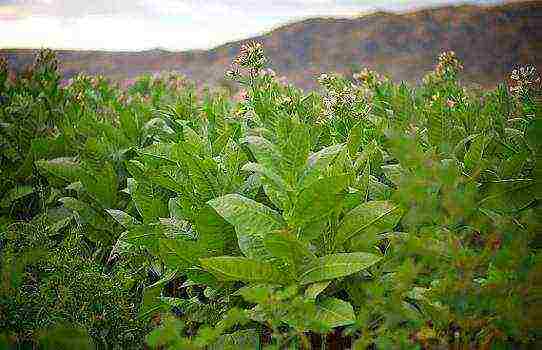
Many people still remember how this business flourished in the 90s of the last century, when the shortage and high cost of tobacco products led to a rise in the popularity of tobacco, which was sold in glasses.
But then sellers of smoking tobacco and their fragrant goods gradually disappeared from the bazaars, unable to withstand competition with cigarette manufacturers.
However, recently, due to a sharp increase in prices for tobacco products and a drop in its quality, many have thought about the possibility of starting their own tobacco growing business.
We will try to answer the question of how profitable such a business can be and what needs to be done to organize it.
But before that, it is useful to get some idea of the methods of growing smoking tobacco in our climate. Tobacco and makhorka varieties
Before proceeding with the purchase of seeds, it should be recalled that only a few varieties of smoking tobacco and makhorka have been tested in our country. Therefore, it would be wise to start your business with them.
As for smoking tobacco, these are:
- Refectory 219;
- Anniversary;
- Holly 215
- Meal 15.
Shag varieties:
- Pekhlets local;
- Pekhlets 4;
- Datura 4.
Recently, varieties of smoking tobacco have gained popularity - Kentucky Burley and Ternopil 14.
Ternopil 14 is an unusually fragrant variety, bred specifically for cultivation in Eastern Europe.
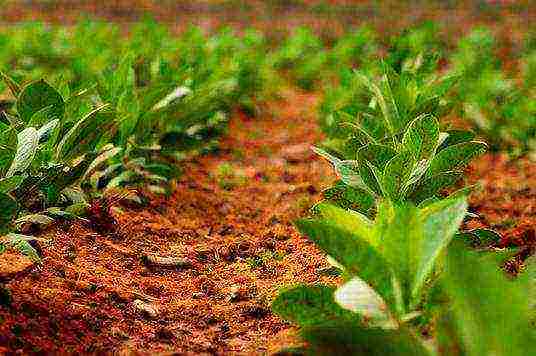
Kentucky Burley is also an adapted variety, interesting for its extremely low sugar content, due to which its leaves do not ferment. Once dried, they can be steamed and cut for consumption. Germinating seeds
The tobacco growing business requires particularly accurate adherence to the technological process, since otherwise the entire fragrant product will be hopelessly spoiled.
The growing methods of tobacco and makhorka are very similar. The main difference is that the ripening period of seedlings in makhorka is almost two times shorter. It is 70-80 days, respectively, tobacco matures in 100-120 days.
Planting tobacco seeds for seedlings is not carried out in the garden, in open ground. In the apartment, they are planted in flower pots or boxes placed on the windowsills on the south side. But more often greenhouses are used for growing seedlings. From planting seeds to planting seedlings in the ground, it takes 40-45 days.
A few days before sowing, the seeds are soaked for a day in a very weak solution of tartaric acid at an air temperature of 25-30 degrees, at the rate of 3 ml of solution per gram of seeds. Thanks to this procedure, seedlings ripen a week earlier, and seed germination increases by 20%.
After a day of soaking, the seeds extracted from the solution are slightly dried and, while still wet, are laid out in enamel or ceramic containers with a layer about 30 mm thick. In this form, they are kept for several days, stirring 5-6 times a day and moisturizing. In this case, the air temperature should be 27-28 degrees.
For sowing in a greenhouse, a nutrient layer is created, consisting of ¾ of humus, and ¼ of sand. Its thickness is 10 cm.The seeding rate for tobacco is 4 g of seeds per 10 m2, and for tobacco is 20 g.
Tobacco seeds are planted to a depth of about 0.3 cm, and tobacco seeds - 0.7 cm.
Since the planting of germinated seeds in a greenhouse or greenhouse takes place in late February - early March, the greenhouses must be heated. The area of such a greenhouse does not exceed a few m2, so it will not take up much space in the garden.
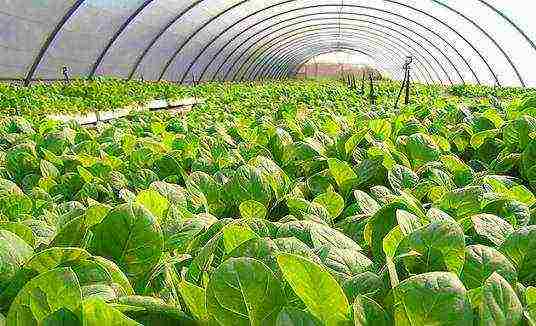 Growing seedlings
Growing seedlings
- Before and after planting, the nutrient layer must be moistened, based on a square meter of soil - a liter of water.As the plants grow, the watering rate increases to 4 liters per square meter.
- At the same time, the air temperature in the greenhouse decreases, from 27 to 20 degrees.
- During the cultivation of seedlings, it is poured 3-4 times.
- Plant feeding is carried out with a solution of ammonium nitrate, superphosphate and potassium salt, at the rate of 30 g of nitrate, 50 g of superphosphate, 20 g of potassium salt per 10 liters of water.
- For feeding a square meter of a garden bed, 2 liters of solution are consumed.
- As an organic feeding, a solution of fermented chicken manure is used, diluted with water in a ratio of one to seven.
- A week before transplanting seedlings into open ground, the intensity and volume of watering is radically reduced, and the last three days before transplanting, the plants are not watered at all.
- A characteristic of a well-hardened plant is the elasticity of its stem, which does not break when bent.
- Two hours before the start of transplanting seedlings, it is poured abundantly with water to facilitate the extraction of plants from the soil.
- A plant ready for transplanting should have a stem about 15 cm high and 0.5 cm thick with several well-developed leaves.
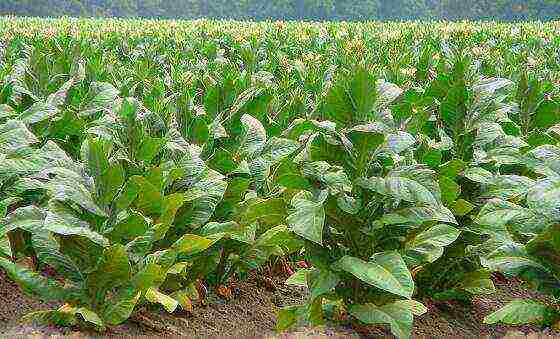 Growing tobacco outdoors
Growing tobacco outdoors
- Transplanting into open ground is carried out no earlier than the ground at a depth of 10 cm warms up to 10 degrees, depending on the climatic zone from mid-April to mid-May.
- Seedlings are planted at a distance of 25-30 cm from each other. In this case, the row spacing must be at least 70 cm.
- Before planting, 0.5 liters of water is poured into each hole, and the roots of the plants are dipped in a mixture of cow dung and clay.
- Plant care consists in regularly loosening row spacings, weeding and feeding. Watering for the entire growing season is carried out two to three times at the rate of approximately 8 liters per plant.
- After the beginning of flowering, plants are pinched.
Combating plant diseases
The most common tobacco diseases are:
- Peronosporosis, against which a 0.4% suspension of zineba is used at the rate of 5 liters per 10 acres or 0.3% polycarbacin solution.
- Aphids, against it, plants are treated with rogor or atelik.
Harvesting and drying of tobacco leaves
To remove tobacco leaves begin from the lower tiers, as soon as they turn yellow. In this case, the leaves must be dry and not damaged.
The removed leaves are transferred to the shade, where they are laid in a layer 30 cm thick for 12 hours so that they are anchored. After that, they are put on the cords to dry.
In the open air, to dry the leaves, choose a place protected from wind and rain. In sunny weather, the drying process is faster and takes about two weeks.
After that, 5-6 folded cords with leaves are hung on a special hook. This design is called a havanka.
Then the gavanoks are transferred to a closed drying room, where they are hung on the beams.
In autumn, the leaves are removed and, having smoothed, put in piles.
 Fermentation of tobacco
Fermentation of tobacco
To obtain scented cigarette tobacco, the dried leaves are fermented. To do this, they are heated in a closed container for three days at a temperature of 50 degrees and a humidity of 65%.
After that, within a week, the air humidity is gradually increased, at the same temperature, up to 75%.
Then, within two days, the temperature gradually decreases, and the humidity increases to 80%.
Then the tobacco leaves must be cooled to room temperature in three days, while their humidity should be from 11 to 16%.
After that, they are laid out for resting, the duration of which is one month.
The remaining tobacco is cut into strips about 0.5 mm wide. A cigarette 80 mm long and 8 mm in diameter requires about a gram of tobacco.
It is believed that good quality cigarette tobacco should consist of a mixture of at least two varieties.
As for makhorka, to improve the taste, as already mentioned, a fragrant sweet clover or another aromatic additive of natural origin, such as, for example, fragrant St. John's wort, is added to it.
Profitability
We will make a preliminary calculation of the profitability of growing tobacco on a plot of 10 acres.
It takes about 0.4 g of seeds to sow per square meter. Therefore, to plant 1000 m2 it will take 400 g.
At retail, Virginia tobacco costs 1,900 rubles per gram, and makhorka is 1,500 rubles.
That is, to purchase tobacco seeds for 10 acres, we need 76,000 rubles, and makhorka - 60,000 rubles.
The output of finished tobacco of the first grade per hectare is 2-3 tons, that is, from 10 ares 200-300 kg, makhorka, respectively, 300-400 kg.
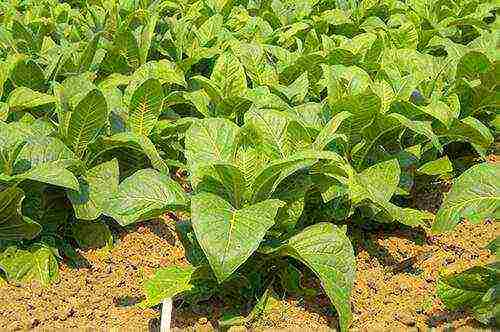
Mahorka can be sold in bulk at a price of 400-500 rubles / kg, respectively, the gross income from the sale will be about 200,000 rubles. Subtracting the cost of seeds, we get a net income equal to 140,000 rubles.
The situation with cigarette tobacco is more interesting, since, on the one hand, the requirements for it are much higher, but on the other hand, it costs much more.
Good quality unpackaged cigarette tobacco can be sold in bulk at a price of about 2000 r / kg. In this case, gross income is RUB 60,000 and net income is RUB 524,000. Sales of products
For this business, well-established sales of products are very important. With such relatively small volumes of production, its profitability can be significantly increased if it is possible to establish retail trade in tobacco. And for this it is not necessary to sell it in your store, you can try to sell it via the Internet.
But it should be remembered that the tobacco trade is governed by rather convoluted rules. Therefore, before proceeding with it, it makes sense to consult with an experienced lawyer who will help you collect the necessary papers.
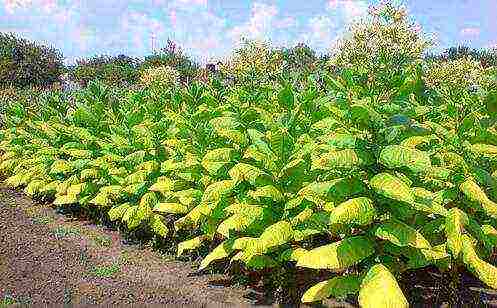 Conclusion
Conclusion
As you can see, when calculating, we did not use the cost of fertilizers and the cost of equipping dryers and greenhouses.
The fact is that starting a business, you can get by, for example, a heated attic where you can germinate seeds, grow seedlings and dry tobacco leaves. This will require not so much material as labor costs.
As for fertilizers, we took the minimum yield, which implies an insignificant amount of their use.
If the first season turns out to be successful, then the income received will be enough to start purchasing and installing the appropriate equipment, as well as to apply fertilizers on a wider scale. This will have a beneficial effect on the quality and quantity of the future harvest and will lead to increased income.
It is not difficult to grow tobacco or makhorka; these crops have no more secrets than vegetables. True, you will have to tinker with the post-harvest processing of tobacco - to ferment it so that it becomes fragrant. But this is no more difficult than canning cucumbers. If you smoke, boldly follow the path of the ancient Indians, from whose "backyards" tobacco came to us.
If makhorka grows everywhere: from the south of Russia to the Arctic, then tobacco is more thermophilic. He succeeds well south of 55 ° north latitude, approximately this line passes through Ryazan, Smolensk, Ulyanovsk, Ufa, Chelyabinsk, Kurgan, Omsk, Novosibirsk, Kemerovo.
Tobacco varieties for cultivation
It is better to choose zoned varieties. So, Trapezond Kubanets and Trapezond 162 are recommended along with the North Caucasian for the West Siberian region. Sigarny 17 and Bryansky 91 are considered the best for the Central, and Trapezond 15 - for the Central Black Earth region. Most varieties have been created and zoned for the North Caucasus, where tobacco is a traditional culture.
On a personal plot, I advise you to plant Trapezond 15 and Trapezond Kubanets. They ripen in 100 days, a month earlier than many other varieties. Plastic - quickly adapt to different climatic conditions, while maintaining good smoking properties.
Beds and tobacco seeds
The average smoker smokes up to 8 kg of tobacco per year. Based on this, we will determine the planting area so as not to look at the tobacco kiosk for a whole year.
Under favorable conditions, about 30 g of smoking tobacco can be obtained from one plant, and six to seven plants can be placed per 1 square meter. The planting density of large-leaved varieties is 70 x 30 cm, and the planting density of medium-sized tobacco and makhorka is 70 x 20 cm.It turns out that you need to grow 270-300 plants, occupying about 40 square meters. m. plot.
The seeds of the crops in question are as small as dust. In one gram there are about 12.5 thousand pieces of tobacco seeds, makhorka - 4 thousand pieces. To get the annual "norm" of a smoker, you need to sow only a quarter of a gram of tobacco seeds or three-quarters of a gram of tobacco seeds.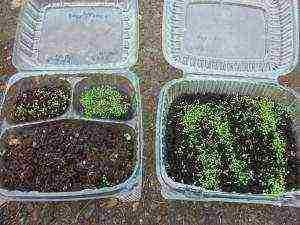
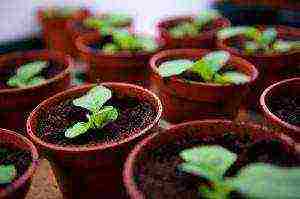
Sowing and planting tobacco
Tobacco and makhorka are grown through seedlings, with or without a pick. The seedlings are 40-45 days old. It works well in a greenhouse, greenhouse, on a sunlit windowsill in a room - in a flower pot or wooden box, where nutrient soil is poured with a layer of 8-10 cm.
It is easier to sow dry seeds, but better to sow seeds. In this case, 4-5 days before sowing, the seeds in a cloth must be soaked in warm clean water, you can add a few drops of tartaric acid or a few crystals of potassium nitrate to it. The soaking time is 24 hours. This accelerates the germination of seeds, reduces the time for forcing seedlings by 5-7 days. It develops better, the yield increases.
Then rinse the seeds, remove excess water and put on germination in an enamel or earthenware dish in a warm place, and it is better not to cover. Moisten the rag periodically. Usually on the 3-4th day the seeds are pecked: white "dots" appear. A sprout longer than the seed should not be allowed to form: such sprouts break off easily. When two-thirds of the seeds are nibbled, they must be dried to flowability, mixed with well-disinfected fine sand or crushed humus. If germinated seeds cannot be sown immediately, then they can be stored for a day or two at a temperature of plus 1-2 ° in the refrigerator.
Important! The seeding depth is no more than 0.3-0.5 cm for tobacco, 0.7-0.8 cm for tobacco. Sprinkle the seeds with humus and sand (3: 1). Water the soil before and after sowing through a thick strainer.
Watering small-seeded crops is a delicate matter. It is impossible to overmoisten, as well as overdry the seedlings. It is best to water a little, almost daily. Before the “cross” phase (cotyledons and two true leaves growing across) usually consume only 0.5 liters of water per sowing box; keep crops where it is warmer + 23 + 25 °. Then it is desirable to lower the temperature to 20 °, and double the watering until the “ears” phase (3-4 true leaves usually stick up). It is better to dive seedlings in the "ears" stage.
Sprinkle the seedlings with fertile soil two or three times and feed them with a solution of mineral fertilizers (for 10 liters of water, 30 g of ammonium nitrate, 20 g of sulphate or potassium chloride). You can use an infusion of chicken manure: pour 1 kg into 10 liters of water, leave for 10-12 days for fermentation, stir from time to time. Strain the fermented mass and add 4-5 parts of water to 1 part of the liquid.
Seedlings are planted with a height of 14-16 cm, having 5-6 developed leaves, not counting the cotyledons, a stem 0.3-0.5 cm thick and a well-developed root system.
Seedlings should be hardened 7-8 days before planting, reducing watering and accustoming them to open air. 2-3 days before planting, watering not dived seedlings completely stop. Water the seedlings 2-3 hours before planting.
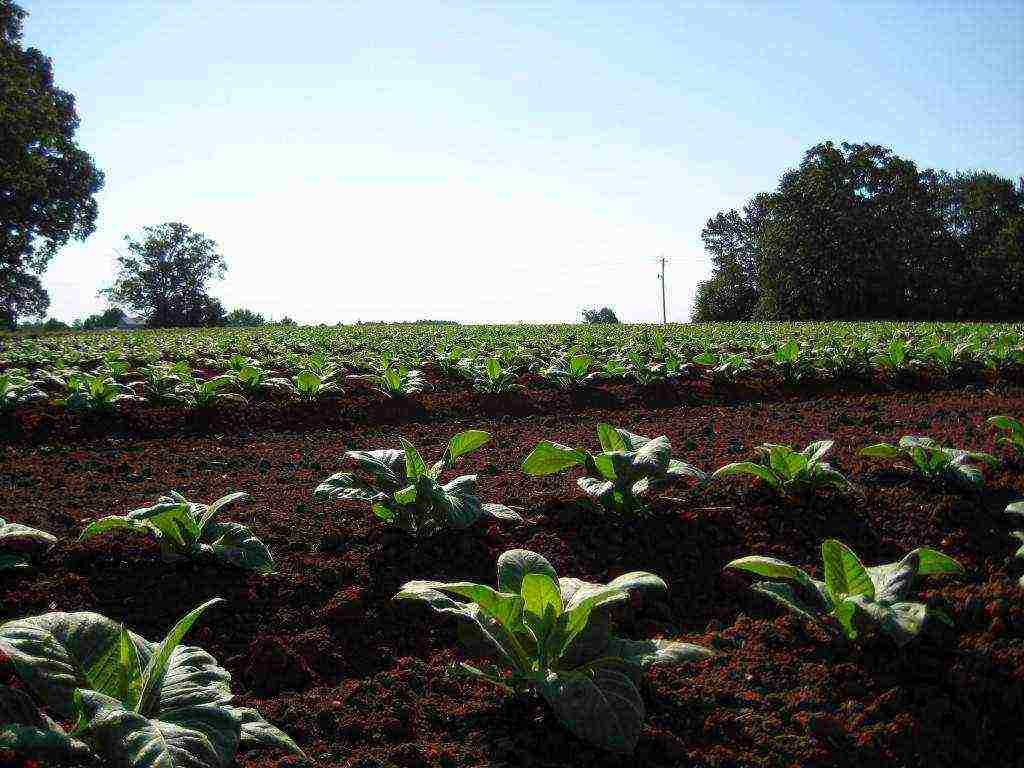
They start planting in the ground when the danger of spring frosts has passed, and the soil temperature at a depth of 10 cm rises to 10 °, from about April 20 to May 25. Make holes along the prepared furrow, pour 0.5 liters of water into them and spread the seedlings. With your right hand, deepen the hole with a peg, place the seedlings vertically into it with your left hand, press the moist soil to the roots, and sprinkle dry soil on top so that the moisture evaporates less. It makes sense to plant extended seedlings deeper - additional roots will grow.
During the growing season, regularly loosen the soil, remove weeds, feed and water.You can feed based on the fertilization rates of tomatoes. Usually they are limited to two or three waterings per summer, spending 6-8 liters of water per plant. It itself will tell you: if the leaves have wilted a little, watering is needed. But it is better to underwater than overmoisten.
In flowering plants, break off the inflorescences (vershoking) and regularly remove the lateral shoots (pinching).
S. Cherkasov, candidate of agricultural sciences. The magazine "Household economy".
Tobacco growing, video

